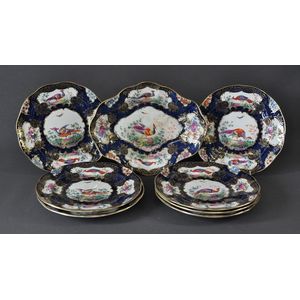Late 18th Century Worcester Plates & Tea Bowl Set
You must be a subscriber, and be logged in to view price and dealer details.
Subscribe Now to view actual auction price for this item
When you subscribe, you have the option of setting the currency in which to display prices to $Au, $US, $NZ or Stg.
- Kakiemon Porcelain - Kakiemon porcelain was made from the 16th to the 19th century in the Arita area of Japan, and is generally agreed to include some of the finest porcelain made in Japan. It is decorated with polychrome enamels over glaze, the most popular colours being underglaze blue and enamels of green, blue, turquoise yellow and persimmon red.
The body of a Kakiemon object is pure white porcelain while the enamel overglaze motifs incorporate Japanese and Chinese designs, but leave much of the white surface unpainted. The name derives from the family of potters who are associated with this style of pottery.
Early Kakiemon porcelain was unmarked, and marks on later objects were variable and unreliable.
Kakiemon porcelain was first imported into Europe by the Dutch at the end of the 17th century, and became extremely popular, resulting in Kakiemon-style imitations being produced by European potteries including Bow, Chelsea and Worcester in England, Mennery, Samson and St. Cloud in France, Delft in Holland and Meissen in Germany.
It's rare for an original Kakiemon object to come onto the market, and almost all sold nowadays is of European origin, and described as Kakiemon pattern or Kakiemon style. - Ho Ho Bird - The ho ho bird is a mythological bird of the East, that in appearance is a composite of many birds including the head of a pheasant, the body of a mandarin duck and the tail of a peacock.
It is used as a decorative motif in both European and Eastern furnishings and decorative arts, especially on ceramics and as part of the carved frame of mirrors.
This item has been included into following indexes:
- Worcester (England), item types - tea bowls 128
- Worcester (England), patterns
Visually similar items

Edwardian Booths 9 piece fruit set. 7 plates, bowl and dish (crazing). Pheasant decoration; cobalt blue ground

A pair of floral plates in the manner of Coalport, circa 1815-20, with gilded rococo reserves enclosing loose arrangements and sprigs of spring flowers in a bright palette, and centred with a floral roundel upon a wet scale cobalt ground; unmarked, diamete

A ten piece Herend Hungarian porcelain bachelor's tea set, 20th century, the tray 39 cm diameter

Six polychrome Majolica biscuit plates, with vine leaf decoration, 15.5 cm diameter.
